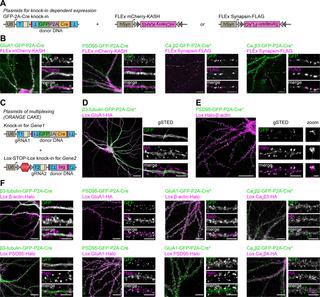当前位置:
X-MOL 学术
›
PLOS Biol.
›
论文详情
Our official English website, www.x-mol.net, welcomes your
feedback! (Note: you will need to create a separate account there.)
ORANGE: A CRISPR/Cas9-based genome editing toolbox for epitope tagging of endogenous proteins in neurons.
PLOS Biology ( IF 7.8 ) Pub Date : 2020-04-10 , DOI: 10.1371/journal.pbio.3000665 Jelmer Willems 1 , Arthur P H de Jong 1 , Nicky Scheefhals 1 , Eline Mertens 1 , Lisa A E Catsburg 1 , Rogier B Poorthuis 2 , Fred de Winter 3 , Joost Verhaagen 3 , Frank J Meye 2 , Harold D MacGillavry 1
PLOS Biology ( IF 7.8 ) Pub Date : 2020-04-10 , DOI: 10.1371/journal.pbio.3000665 Jelmer Willems 1 , Arthur P H de Jong 1 , Nicky Scheefhals 1 , Eline Mertens 1 , Lisa A E Catsburg 1 , Rogier B Poorthuis 2 , Fred de Winter 3 , Joost Verhaagen 3 , Frank J Meye 2 , Harold D MacGillavry 1
Affiliation

|
The correct subcellular distribution of proteins establishes the complex morphology and function of neurons. Fluorescence microscopy techniques are invaluable to investigate subcellular protein distribution, but they suffer from the limited ability to efficiently and reliably label endogenous proteins with fluorescent probes. We developed ORANGE: Open Resource for the Application of Neuronal Genome Editing, which mediates targeted genomic integration of epitope tags in rodent dissociated neuronal culture, in organotypic slices, and in vivo. ORANGE includes a knock-in library for in-depth investigation of endogenous protein distribution, viral vectors, and a detailed two-step cloning protocol to develop knock-ins for novel targets. Using ORANGE with (live-cell) superresolution microscopy, we revealed the dynamic nanoscale organization of endogenous neurotransmitter receptors and synaptic scaffolding proteins, as well as previously uncharacterized proteins. Finally, we developed a mechanism to create multiple knock-ins in neurons, mediating multiplex imaging of endogenous proteins. Thus, ORANGE enables quantification of expression, distribution, and dynamics for virtually any protein in neurons at nanoscale resolution.
中文翻译:

橙色:基于CRISPR / Cas9的基因组编辑工具箱,用于神经元内源性蛋白质的表位标记。
蛋白质正确的亚细胞分布建立了神经元的复杂形态和功能。荧光显微镜技术对于研究亚细胞蛋白的分布是无价的,但是它们受荧光探针有效和可靠地标记内源蛋白的能力有限。我们开发了ORANGE:神经元基因组编辑应用的开放资源,该介质介导了啮齿动物离体的神经元文化,器官型切片和体内表位标签的靶向基因组整合。ORANGE包括一个用于深入研究内源蛋白质分布的敲入文库,病毒载体,以及详细的两步克隆方案以开发用于新靶标的敲入。使用ORANGE和(活细胞)超分辨率显微镜,我们揭示了内源性神经递质受体和突触支架蛋白,以及以前未表征的蛋白的动态纳米级组织。最后,我们开发了一种机制,可在神经元中创建多个敲入,介导内源蛋白质的多重成像。因此,ORANGE能够以纳米级分辨率量化神经元中几乎任何蛋白质的表达,分布和动力学。
更新日期:2020-04-10
中文翻译:

橙色:基于CRISPR / Cas9的基因组编辑工具箱,用于神经元内源性蛋白质的表位标记。
蛋白质正确的亚细胞分布建立了神经元的复杂形态和功能。荧光显微镜技术对于研究亚细胞蛋白的分布是无价的,但是它们受荧光探针有效和可靠地标记内源蛋白的能力有限。我们开发了ORANGE:神经元基因组编辑应用的开放资源,该介质介导了啮齿动物离体的神经元文化,器官型切片和体内表位标签的靶向基因组整合。ORANGE包括一个用于深入研究内源蛋白质分布的敲入文库,病毒载体,以及详细的两步克隆方案以开发用于新靶标的敲入。使用ORANGE和(活细胞)超分辨率显微镜,我们揭示了内源性神经递质受体和突触支架蛋白,以及以前未表征的蛋白的动态纳米级组织。最后,我们开发了一种机制,可在神经元中创建多个敲入,介导内源蛋白质的多重成像。因此,ORANGE能够以纳米级分辨率量化神经元中几乎任何蛋白质的表达,分布和动力学。


















































 京公网安备 11010802027423号
京公网安备 11010802027423号